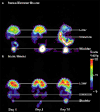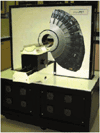Recent advances in imaging endogenous or transferred gene expression utilizing radionuclide technologies in living subjects: applications to breast cancer
- PMID: 11250742
- PMCID: PMC139436
- DOI: 10.1186/bcr267
Recent advances in imaging endogenous or transferred gene expression utilizing radionuclide technologies in living subjects: applications to breast cancer
Abstract
A variety of imaging technologies is being investigated as tools for studying gene expression in living subjects. Two technologies that use radiolabeled isotopes are single photon emission computed tomography (SPECT) and positron emission tomography (PET). A relatively high sensitivity, a full quantitative tomographic capability, and the ability to extend small animal imaging assays directly into human applications characterize radionuclide approaches. Various radiolabeled probes (tracers) can be synthesized to target specific molecules present in breast cancer cells. These include antibodies or ligands to target cell surface receptors, substrates for intracellular enzymes, antisense oligodeoxynucleotide probes for targeting mRNA, probes for targeting intracellular receptors, and probes for genes transferred into the cell. We briefly discuss each of these imaging approaches and focus in detail on imaging reporter genes. In a PET reporter gene system for in vivo reporter gene imaging, the protein products of the reporter genes sequester positron emitting reporter probes. PET subsequently measures the PET reporter gene dependent sequestration of the PET reporter probe in living animals. We describe and review reporter gene approaches using the herpes simplex type 1 virus thymidine kinase and the dopamine type 2 receptor genes. Application of the reporter gene approach to animal models for breast cancer is discussed. Prospects for future applications of the transgene imaging technology in human gene therapy are also discussed. Both SPECT and PET provide unique opportunities to study animal models of breast cancer with direct application to human imaging. Continued development of new technology, probes and assays should help in the better understanding of basic breast cancer biology and in the improved management of breast cancer patients.
Figures








References
-
- Budinger TF. Critical review of PET, SPECT and neuroreceptor studies in schizophrenia. J Neural Transm. 1992;36(suppl):3–12. - PubMed
-
- Fleming JS, Alaamer AS. Influence of collimator characteristics on quantification in SPECT. J Nucl Med. 1996;37:1832–1836. - PubMed
-
- Cherry SR, Shao Y, Silverman RW, Meadors K, Siegel S, Chatziioannou A, Young JW, Jones WF, Moyers JC, Newport D, Boutefnouchet A, Farquhar TH, Andreaco M, Paulus MJ, Binkley DM, Nutt R, Phelps ME. MicroPET: a high resolution PET scanner for imaging small animals. IEEE Trans Nucl Sci. 1997;44:1161–1166. doi: 10.1109/23.596981. - DOI
Publication types
MeSH terms
Substances
Grants and funding
LinkOut - more resources
Full Text Sources
Other Literature Sources
Medical
Molecular Biology Databases

